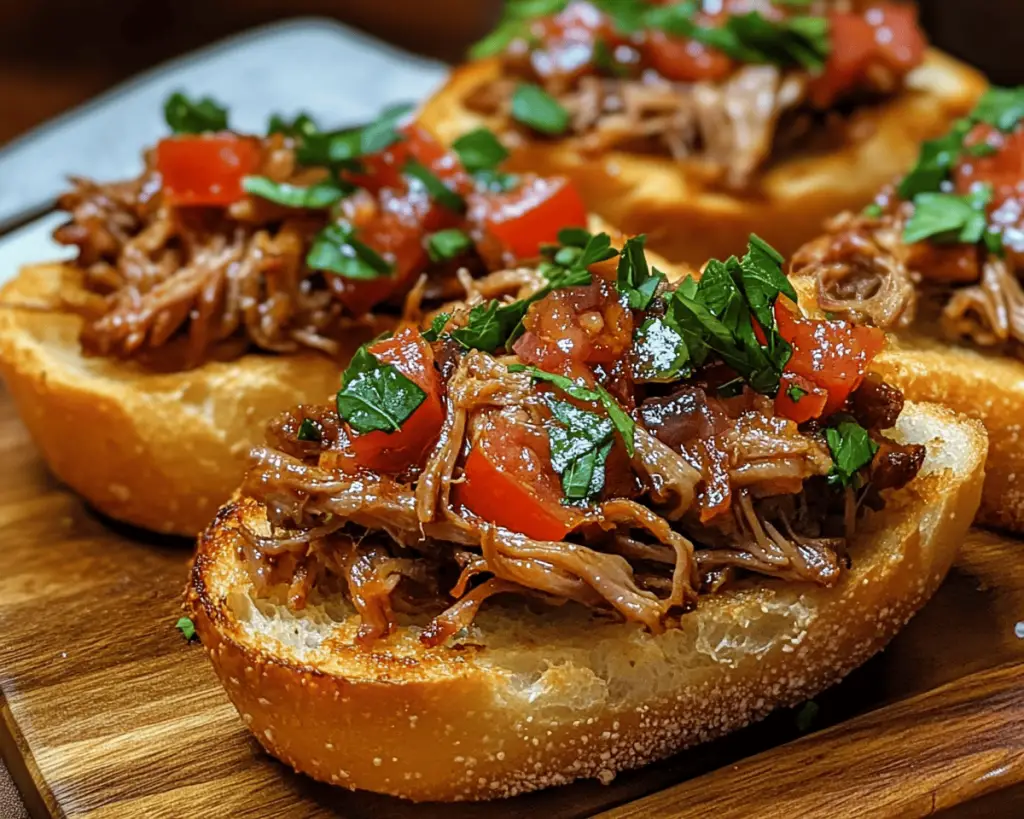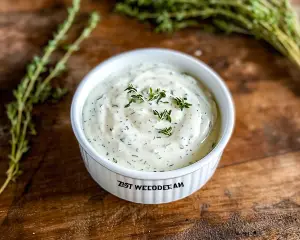Every time I think of pulled pork crostini, I’m reminded of sun-soaked afternoons spent at backyard barbecues, surrounded by the laughter of friends and family. It was during one of those warm gatherings that this delightful appetizer whisked its way into my heart, courtesy of my dear friend Lily. She had a knack for transforming humble ingredients into something magical, and her pulled pork crostini was no exception. The first bite was an explosion of flavors: the tender, smoky pork melting in my mouth, the crunch of the bread, and the fresh burst of herbs dancing on my palate. It was a dish that not only delighted my taste buds but also signified the joy of communal eating—a celebration of love, laughter, and rich flavors.
Since that initial introduction, I’ve made this dish a staple in my kitchen. It’s become a beloved appetizer for gatherings big and small. What I love about pulled pork crostini is its versatility; whether you’re hosting a lavish holiday feast or a casual family dinner, these little bites can elevate any occasion. Moreover, it’s a dish that beautifully exemplifies the ethos of cooking: you can take a few everyday ingredients and turn them into something truly special with a bit of time and attention.
As we embark on this culinary adventure together, let’s take a moment to appreciate the ingredients that make this dish shine not just in flavor but also in comfort and warmth.
Inside the Ingredients of Pulled Pork Crostini
Pulled Pork: At the heart of this dish is, of course, the pulled pork itself. Typically made from a hunk of pork shoulder, this cut is favored for its marbling and collagen, which break down during the long, slow cooking process. The result is succulent, tender meat that falls apart with just a fork—perfect for nesting atop a crisp crostini. While traditional pulled pork is often seasoned with a blend of spices and slow-cooked in the oven or a smoker, I’ve found that you can also achieve delightful results using a slow cooker or instant pot for convenience.
Crostini: This refers to the toasted bread base that provides both texture and a vehicle for the pork. Traditionally, crostini are made from thinly sliced baguette. I’ve experimented with different types of bread, including ciabatta, sourdough, and even whole-grain varieties, depending on what I had on hand. Each brings its own character to the dish. To achieve that perfect crunch, I slice the bread about half an inch thick and toast it until it’s nice and golden.
BBQ Sauce: The choice of barbecue sauce can drastically influence the flavors of your pulled pork crostini. I love a smoky, tangy sauce that complements the richness of the pork. While I often whip up my own homemade barbecue sauce, which allows me to control the sweetness and heat levels, I also keep an eye out for high-quality store-bought options that can save time without sacrificing flavor. A good barbecue sauce can truly be the difference between a good dish and a great one.
Fresh Herbs: Topping these little bites with fresh herbs like parsley or cilantro adds brightness, balancing the richness of the pork. While some might opt for a sprinkle of dried herbs for convenience, I strongly advocate for using fresh when possible. The aromatic oils in fresh herbs invigorate the dish and elevate it to new heights.
Cheese: Many times, I’ve added a layer of creaminess with cheese, whether it’s a spreadable goat cheese, tangy feta, or a sharp cheddar. The cheese melts beautifully under the warmth of the pulled pork, creating a delightful texture contrast. The addition is purely optional, but I find it to be a worthwhile touch that enhances the flavor profile.
Pickled Jalapeños or Red Onions: If you enjoy a little heat, adding pickled jalapeños or red onions can introduce a delightful tang that cuts through the richness of the pork. The zesty bite of pickled ingredients brings a layer of complexity and surprise to each crostini. Alternatively, you can use fresh slices if you’re looking for a milder option.
Nutritional Considerations
How Pulled Pork Crostini Fits Into a Balanced Life
One of the joys of cooking is that it allows us to indulge in our cravings without straying from a balanced diet. Pulled pork crostini beautifully straddles that line. On one hand, they are an appetizer that folks can’t resist, yet they also encapsulate nutritional benefits when made conscientiously.
The star of the dish—the **pulled pork**—is a great source of protein, particularly when sourced from quality pork that isn’t overly fatty. Protein aids in muscle repair and keeps us feeling satiated longer, an essential aspect when entertaining. Alongside this, the **crostini**, made from whole grain breads, can provide fiber which is good for digestion and overall well-being.
When topped with fresh **herbs**, you’re incorporating a wealth of vitamins and antioxidants that contribute to your health. They may seem small in quantity, but their impact is significant. On the other hand, incorporating elements like **cheese** does introduce fat, which is not inherently bad when consumed in moderation. It’s about balance—when I indulge in the rich, tender pork and enjoy the crunch of the crostini, I also take joy in the complementary elements that round out the dish’s healthful offerings.
Of course, if dietary restrictions are a concern, these crostini can be adapted easily. Swap in a **vegan BBQ** made from jackfruit or tempeh for a plant-based option, and use gluten-free bread for those sensitive to gluten. The versatility of this recipe allows it to fit into various dietary lifestyles without feeling restricted.
What You’ll Need
What You’ll Need
– **1.5-2 lbs pork shoulder (or pork butt)**
– **2 cups BBQ sauce (homemade or store-bought)**
– **1 French baguette or ciabatta loaf, sliced into ½-inch pieces**
– **½ cup cheese (goat cheese, feta, or cheddar)**
– **Fresh herbs for garnish (parsley or cilantro)**
– **Pickled jalapeños or red onions (optional)**
– **Salt and pepper to taste**
This recipe makes about 24 crostini, serving 8-10 people as an appetizer.
Preparing Pulled Pork Crostini Step by Step
Preparing Pulled Pork Crostini Step by Step
1. **Season the Pork:**
Begin by seasoning your pork shoulder liberally with salt and pepper. I love to rub it in with my hands, feeling the texture of the meat as I work the seasoning in. This step is often overlooked, but it’s integral for building flavor.
2. **Slow Cook the Pork:**
Place the seasoned pork in your slow cooker or oven (set to 275°F if using the oven) and cover it with half of the BBQ sauce. If you’re using a slow cooker, set it on low and let it cook for about 8 hours until it’s fork-tender. For the oven, it may take about 5-6 hours. The meat should easily shred apart when it’s ready.
3. **Shred the Pork:**
Once cooked, remove the pork from the heat and let it rest for about 15 minutes. This resting period is crucial; it allows the juices to redistribute, making the meat even more tender. After resting, shred the pork with two forks, mixing it back with the remaining BBQ sauce.
4. **Prepare the Crostini:**
While the pork is resting, slice your baguette into half-inch pieces and arrange them on a baking sheet. Brush each slice lightly with olive oil (and sprinkle with salt if you like) before toasting them in the oven at 400°F for about 5-7 minutes, or until golden brown. This is where the magic happens—the aroma of toasting bread is hard to resist!
5. **Assemble the Crostini:**
Spread a thin layer of cheese on each crostini while they are still warm; this helps the cheese melt just enough to blend with the pork. Pile a generous spoonful of pulled pork on each piece, and if desired, add a few slices of pickled jalapeños or thinly sliced red onions to amp up the flavor.
6. **Garnish:**
Finish with a sprinkle of fresh herbs, and voilà! Your pulled pork crostini are ready to be served.
Notes, Lessons, Variations
Lessons from My Kitchen
My journey with pulled pork crostini has been filled with delightful surprises and a few learning curves. One of the biggest lessons I’ve learned is the importance of patience. Pulled pork is not a dish that can be rushed; allowing those deep, rich flavors to develop over a long cooking period is vital. It’s that slow process that encapsulates the spirit of home cooking—a labor of love.
I’ve had my fair share of experimental batches too! There was a rather memorable occasion when I tried to infuse the pulled pork with Asian flavors, mixing in hoisin sauce and ginger. The end result was intriguing, though it strayed a bit far from the traditional BBQ taste I had initially set out for. However, that’s part of the beauty of cooking—embracing the unexpected and being open to culinary exploration.
Another note is to be mindful of the toppings. One summer, I hosted a garden party and added roasted corn and mango salsa atop the crostini for a fresh twist. It was a hit! The sweetness of the corn complemented the smoky pork beautifully. Keeping seasonal ingredients in mind can transform this dish into something new and memorable each time you prepare it.
In terms of presentation, I’ve played around with platters, heights, and layers. Each time I make these crostini, I remind myself that, as much as flavor matters, the visual impact of food cannot be underestimated. A colorful assortment alongside garnishing herbs creates anticipation before the first bite, which is always half the pleasure of a good meal.
Closing Thought
As we come full circle, I’m reminded that food is much more than sustenance; it’s a connection to our past, a way to express love, and a means to create memories. I hope that through these pulled pork crostini, you can find a slice of joy for your gatherings, just as I did when I first tasted Lily’s version. Whether you share this dish at celebrations or intimate family dinners, I trust that every bite will remind you of the warmth of shared meals and the love that goes into them. Here’s to many joyful culinary adventures in your kitchen!



